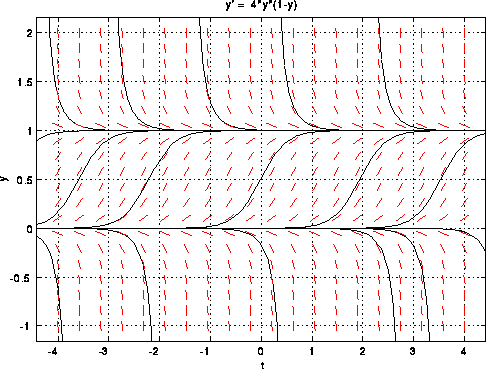
Consider the autonomous ode y'=4y(1-y). The differential equation gives
a
formula for the slope. In this
example, the slope just depends on the
independent variable.
If the function passes through the point (1,2), the slope
is -8.
The slope is independent of t, so the slope is constant if
y is constant.
The following table lists the slope
at several y points.
Slopes for Model ODE

The direction field consists of small lines which characterize
the slope of y(t)
at each point in the t-y plane Here is
the direction field for our example.

For example, if y(t) passes through the point (1,2) it should
have a slope of -8.
This is shown by the small line with large
negative slope. If y(t) passes through
(1,0.5), the slope is 1,
and this shown by the line with moderate positive slope.
The direction field gives us a rough idea about solutions to
the differential
equation, since solutions to the differential
equation are tangent to the small
slope lines. The following plot
draws in the solutions.

The plot above gives us qualitative information about solutions
to the
differential equation. There are several points to note:
Note that there are several solution curves. Actually,
the ode has an
infinite number of solutions. Why? Each solution corresponds
to a different
initial condition. For example, if y(0)=0.5, then we have
a solution that
apparently increases to 1 as t -> infinity.
y(t)=0 and y(t)=1 are solutions to the differential equation.
This is easy to
verify. If y=1, for example, then y'=0 and 4y(1-y)=0.
Hence, the differential
equation is satisfied. A similar calculation
shows
that y=0 is a solution to the
ode. In general, for an autonomous ode
of
the form y'=f(y), the zeros of f(y)
are constant solutions to the ode.
We verify this: let y(t)=c. Then y'=0 and
f(y)=f(c)=0, and the ode is
satisfied.
We can extract a lot of information about solutions to
the ode from the
plot above without knowing the precise mathematical
formula
for the
solution.
The above conclusions are based on the fact that two solutions to
an ode
do not, in general, intersect. Although is looks as if solutions
intersect with
the lines y=0 and y=1, they are in fact asymptotic to
these lines.
Here is a summary of the procedure for doing a
qualitative analysis of
autonomous ode y'=f(y).
[ODE Home] [1st-Order Home] [2nd-Order Home] [Laplace Transform Home] [Notation] [References]
Copyright © 1996 Department of Mathematics, Oregon State University
If you have questions or comments, don't hestitate to contact us.